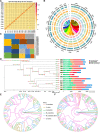Plant-on-chip: Core morphogenesis processes in the tiny plant Wolffia australiana
- PMID: 37181047
- PMCID: PMC10169700
- DOI: 10.1093/pnasnexus/pgad141
Plant-on-chip: Core morphogenesis processes in the tiny plant Wolffia australiana
Abstract
A plant can be thought of as a colony comprising numerous growth buds, each developing to its own rhythm. Such lack of synchrony impedes efforts to describe core principles of plant morphogenesis, dissect the underlying mechanisms, and identify regulators. Here, we use the minimalist known angiosperm to overcome this challenge and provide a model system for plant morphogenesis. We present a detailed morphological description of the monocot Wolffia australiana, as well as high-quality genome information. Further, we developed the plant-on-chip culture system and demonstrate the application of advanced technologies such as single-nucleus RNA-sequencing, protein structure prediction, and gene editing. We provide proof-of-concept examples that illustrate how W. australiana can decipher the core regulatory mechanisms of plant morphogenesis.
Keywords: Wolffia australiana; high-quality genome; morphogenesis; plant-on-chip.
© The Author(s) 2023. Published by Oxford University Press on behalf of National Academy of Sciences.
Figures






References
-
- Waddington CH. 1966. Principles of development and differentiation. New York: The Macmillan Company.
-
- Wang R, et al. . 2009. PEP1 regulates perennial flowering in Arabis alpina. Nature 459:423–427. - PubMed
-
- Landolt E. 1957. Physiologische und okologische untersuchungen an lemnaceen. Ber Schweiz Bot Ges. 67:271–410.
-
- Hillman WS. 1961. The Lemnaceae, or duckweeds: a review of the descriptive and experimental literature. Bot Rev. 27:221–287.
-
- Landolt E, Kandeler R. 1986. The family Lemnaceae—monographic study. Zürich: Geobotanische Institut ETH, Stiftung Rübel.
LinkOut - more resources
Full Text Sources

